Urban Trees: Boosting Economy & Wildlife in Cities (2024)
Introduction
In the concrete jungles of our modern world, urban trees stand as silent guardians, offering many benefits that extend far beyond their leafy canopies. These green giants play a crucial role in enhancing both our economy and the environment while providing essential habitats for wildlife . Let’s explore the remarkable ways in which urban trees are transforming our cities into thriving ecosystems and economic powerhouses.
Economic Powerhouses: How Urban Trees Boost City Finances
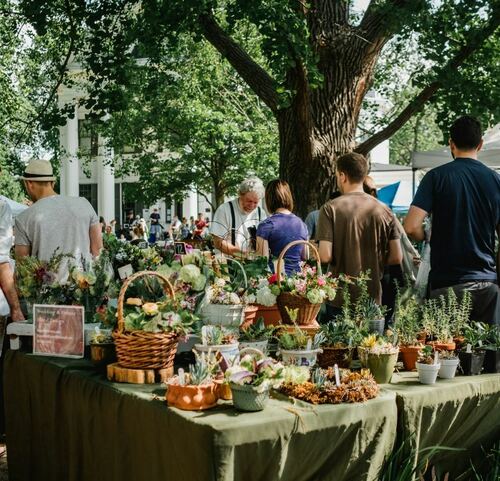
Trees Provide Shade for an Outdoor Market – Image by Kyle Nieber on Unsplash
Urban trees are not just beautiful additions to our cityscape; they’re also powerful economic assets. Their presence can significantly impact a city’s financial health in several ways:
Property Value Boom
Trees lining streets and populating neighborhoods do more than provide shade—they boost property values ! Studies have shown that homes in tree-lined areas can see a 3-to15-percent increase in value compared to similar properties in less green locations. This translates to higher property tax revenues for cities and increased wealth for homeowners.
Energy Savings
Urban trees act as natural air conditioners and insulators. By providing shade in summer and windbreaks in winter, they can reduce a building’s energy consumption by up to 25 percent. This not only lowers energy bills for residents and businesses but also decreases the overall energy demand on city grids.
Tourism Magnet
Green, tree-filled urban spaces are tourist attractions in their own right. Cities with well-maintained urban forests and parks often see increased tourism, bringing in valuable revenue through hotel stays, restaurant visits, and local business patronage.
Job Creation
The care and maintenance of urban forests creates jobs in various sectors:
- Arborists and tree care professionals
- Landscape architects and designers
- Urban planners specializing in green infrastructure
- Environmental educators and researchers
Healthcare Cost Reduction
The presence of trees in urban environments has been linked to improved physical and mental health among residents. This can lead to reduced healthcare costs for cities and individuals alike. For instance, studies have shown that patients with views of trees from their hospital windows recover faster and require less pain medication.
Nature’s Air Purifiers: Urban Trees and Air Quality Improvement

A Sidewalk Lined with Trees in Autumn
One of the most significant environmental benefits of urban trees is their ability to improve air quality. Here’s how they act as nature’s air purifiers:
Pollutant Removal
Trees are incredibly efficient at removing harmful pollutants from the air. Their leaves act as filters, trapping particulate matter and absorbing gaseous pollutants like ozone, nitrogen dioxide, and sulfur dioxide. A single mature tree can remove up to forty-eight pounds of carbon dioxide per year!
Oxygen Production
Through photosynthesis, trees produce the oxygen we breathe. A mature tree can produce enough oxygen in a year to support two human beings.
Urban Heat Island Mitigation
Trees help cool urban areas by providing shade and through transpiration. This cooling effect can reduce the urban heat island effect, where cities are significantly warmer than surrounding rural areas due to heat-absorbing surfaces like concrete and asphalt.
Smog Reduction
By lowering air temperatures and removing air pollutants, trees help reduce the formation of smog, which is particularly problematic in urban areas during hot summer months.
Wildlife Havens: Urban Trees as Crucial Habitats

A Squirrel Peeks Out from its Nest – Image by TheOtherKev on Pixabay
In our bustling cities, urban trees provide essential habitats for a diverse array of wildlife. They serve as miniature ecosystems, supporting biodiversity in ways that might surprise you:
Nesting Sites
Urban trees offer prime real estate for birds and small mammals. From robins building nests in tree branches to squirrels creating dens in tree hollows, these green spaces provide crucial shelter for raising young.
Food Sources
Trees produce a variety of food sources for wildlife:
- Fruits and berries for birds and mammals
- Nuts and seeds for squirrels and other rodents
- Leaves and bark for insects
- Nectar for pollinators like bees and butterflies
Wildlife Corridors
In fragmented urban landscapes, trees can create corridors that allow wildlife to move safely between larger green spaces. This connectivity is essential for maintaining genetic diversity and allowing species to adapt to urban environments.
Microhabitats
A single tree can host an entire ecosystem of smaller creatures:
- Insects living in bark crevices
- Fungi growing on roots and fallen leaves
- Microorganisms thriving in the soil around the tree
Protection from Elements
Urban trees provide shelter from harsh weather conditions and protection from predators, allowing wildlife to thrive even in the heart of the city.
Biodiversity Hotspots
Urban trees contribute significantly to city biodiversity :
- They support a wide range of species, from tiny insects to larger mammals
- Different tree species attract diverse wildlife, creating complex ecosystems
- Older trees, with their hollows and crevices, are particularly valuable for biodiversity
Seasonal Benefits for Wildlife
Trees provide year-round support for urban wildlife:
- Spring: Blossoms provide nectar for pollinators
- Summer: Leafy canopies offer shelter from heat and predators
- Autumn: Fruits and nuts serve as vital food sources
- Winter: Evergreens provide shelter and food when other resources are scarce
Water Warriors: How Urban Trees Manage Stormwater
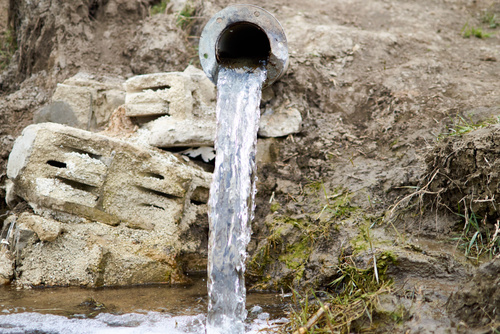
Stormwater Flows from a Drainage Pipe into a Stream
Urban trees play a crucial role in managing one of a city’s biggest challenges: stormwater runoff. Here’s how they help:
Runoff Reduction
Tree roots and the surrounding soil act like sponges, absorbing rainwater and reducing the amount of runoff that flows into storm drains. This can significantly decrease the risk of urban flooding.
Natural Filtration
As water passes through the root systems of trees, pollutants are filtered out, improving the quality of water that eventually reaches our rivers and lakes.
Easing Pressure on Drainage Systems
By absorbing and slowing the flow of rainwater, trees reduce the burden on city drainage systems, potentially saving millions in infrastructure costs.
Groundwater Replenishment
The water absorbed by trees slowly percolates into the ground, helping to replenish groundwater supplies—a vital resource in many urban areas.
Erosion Control
Urban trees play a crucial role in preventing soil erosion :
- Root systems help hold soil in place, especially on slopes
- Leaf litter creates a protective layer over the soil, reducing the impact of heavy rain
- Trees slow the flow of water, allowing more time for absorption and reducing surface runoff
Water Quality Improvement
Trees contribute to cleaner water in urban areas:
- They filter out pollutants like nitrogen, phosphorus, and heavy metals
- Tree roots can break down some toxic substances in the soil
- By reducing erosion, trees prevent sediment from entering waterways
Green Stress Busters: The Mental Health Benefits of Urban Forests
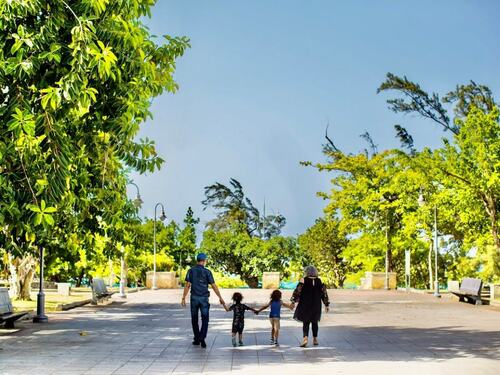
A Family Walks on a Tree-Lined Street – Photo by Caleb Oquendo
The presence of trees in urban environments doesn’t just benefit wildlife and the environment—it also has a profound impact on human mental health:
Stress Reduction
Studies have shown that even brief encounters with nature, such as walking down a tree-lined street, can significantly reduce stress levels and improve mood.
Outdoor Recreation
Urban forests and parks encourage outdoor activities, providing spaces for exercise, relaxation, and social interaction—all crucial for mental well-being.
Cognitive Benefits
Exposure to green spaces has been linked to improved cognitive function, including better concentration and increased creativity.
Community Connections
Urban green spaces foster social connections , providing gathering places for communities and opportunities for shared activities like community gardening.
Noise Reduction
Trees act as natural sound barriers, reducing noise pollution in busy urban areas and creating pockets of tranquility in the city.
Nature Therapy
Urban forests provide opportunities for nature therapy, also known as “forest bathing”:
- Regular exposure to green spaces can boost immune system function
- Time spent among trees can lower blood pressure and reduce stress hormones
- Nature walks can improve mood and reduce symptoms of anxiety and depression
Children’s Development
Urban trees and green spaces play a vital role in children’s development:
- Access to nature improves children’s cognitive development and attention spans
- Outdoor play in green areas enhances motor skills and physical fitness
- Exposure to diverse natural environments can foster creativity and problem-solving skills
Environmental Champions: Urban Trees in the Fight for Sustainability
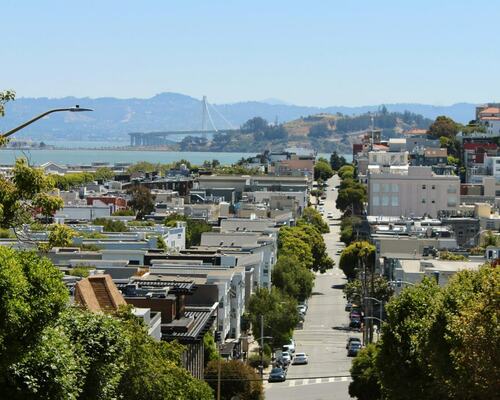
A Hilltop View of San Francisco – Photo by Kalei Winfield
As we face environmental challenges, urban trees emerge as unexpected heroes in the fight for sustainability:
Air Quality Improvement
Trees absorb pollutants and particulate matter from the atmosphere, significantly improving air quality in urban areas.
Temperature Moderation
Urban forests help moderate local temperatures, reducing the need for air conditioning in summer and heating in winter, thus lowering energy consumption and associated emissions.
Resilience Against Extreme Weather
A robust urban forest can increase a city’s resilience to extreme weather events, such as heat waves and floods, which are becoming more frequent in many areas.
Environmental Education
Urban trees provide tangible examples of environmental action, serving as educational tools to raise awareness about sustainability and the importance of green spaces in cities.
Energy Conservation
Urban trees contribute significantly to energy conservation:
- Strategically placed trees can reduce air conditioning needs by 30 percent
- In winter, trees can act as windbreaks, reducing heating costs
- Reduced energy consumption leads to lower utility bills and decreased strain on power grids
Economic Impact: The Hidden Value of Urban Trees
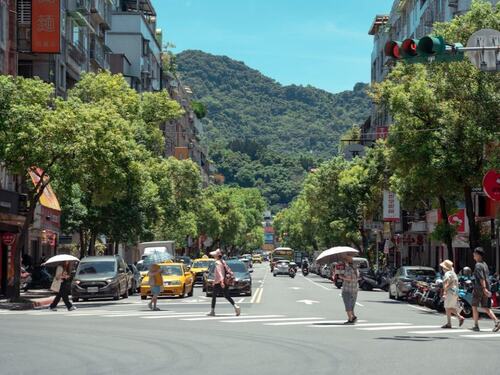
Pedestrians Cross a Tree-Lined Street – Photo by Jimmy Liao
Urban trees provide numerous economic benefits that aren’t always immediately apparent:
Long-term Cost Savings
- Reduced Need for Infrastructure Updates: Trees’ natural stormwater management can delay or reduce the need for costly sewer system upgrades
- Lower Road Maintenance Costs: Shade from trees can slow asphalt deterioration, reducing the frequency of repairs
Increased Business Activity
Trees can boost local economies:
- Shoppers tend to linger longer and spend more in tree-lined business districts
- Greener business areas report lower vacancy rates and higher worker productivity
Health-related Savings
The health benefits of urban trees translate to economic savings:
- Reduced healthcare costs due to improved air quality and increased physical activity
- Fewer sick days taken by workers in greener environments
By considering these wide-ranging benefits, it becomes clear that investing in urban trees is not just an environmental decision but a sound economic one as well.
Conclusion

An Aerial View of Buena Vista Park, San Francisco
Urban trees are true multitaskers, offering a wealth of economic and environmental benefits that extend far beyond their leafy canopies. From filling our city coffers to providing homes for countless wildlife species, these green giants are essential players in creating sustainable, livable urban environments.
As we’ve seen, the benefits of urban trees are numerous and far-reaching:
- They boost property values and create jobs
- Improve air quality and human health
- Provide crucial habitats for urban wildlife
- Manage stormwater and reduce flooding risks
- Enhance mental health and community connections
- Promote sustainability and increase urban resilience
The next time you walk down a tree-lined street or relax in a city park, take a moment to appreciate the hard work these silent guardians are doing for our cities, our wildlife, and our planet. Let’s embrace the power of urban forests and work together to grow greener, healthier cities for all living beings. After all, in the concrete jungle, every leaf counts!
If you’re interested in learning more about how urban trees can benefit your property or community, contact Arborist Now today. Our team of certified arborists is passionate about helping cities and individuals harness the power of urban forestry.


